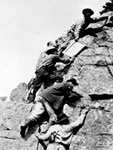Teaching the Transcontinental Railroad
Question

Do you have special materials to teach about the transcontinental railroad and its affects on the West? Specifically looking at those who were part of the labor force building the railroad.
Answer
There are several resources available for teaching about the transcontinental railroad. As always, we recommend using the search function on bottom right of our history content page. Here are a few resources that may be of some use.
The Central Pacific Railroad History Museum's site offers a detailed history and several primary sources regarding the construction of the transcontinental railroad, including, for example, photographs, legislation, and letters. They also have an extensive bibliography of print resources.
The Library of Congress’s American Memory Collection on the Chinese and westward expansion has several primary resources that document the experiences of Chinese laborers during the construction of the transcontinental railroad.
If you are looking to provide your students with a brief overview of the transcontinental railroad check out Digital History’s online textbook.
The virtual Museum of the City of San Francisco provides a brief but informative overview of the leading figures, like Leland Stanford, responsible for the completion of the transcontinental railroad.
Lastly, PBS has a lesson plan that examines two of the landmark documents regarding westward expansion: the Homestead Act and the Pacific Railway Act. Activity three in the lesson asks students to compare the construction of the transcontinental railroad from a variety of perspectives, including those of Chinese laborers. We should note that this lesson draws on a PBS documentary video that is not directly available on the site; but many resources are available on the site, and the activities can be easily adapted .
